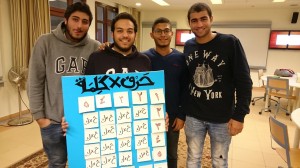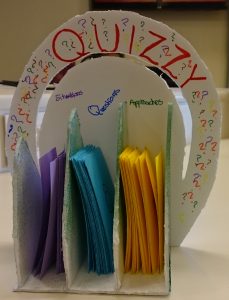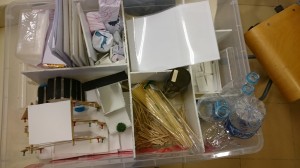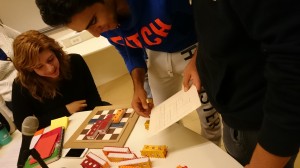Estimated reading time: 7 minutes, 24 seconds
Today was the last day of my educational game design module. It should be a wonderful day, because students are so proud of what they create, I am so proud of them, and we all have fun. Which did happen today. But the problem is that most people (with their games) showed up late, and with 1:15 of class time, starting 15 mins late and playing 4 games, time was supertight. Because of that, it was more like a quick demo/exhibit of each game, rather than a full-fledged playing of each game.
The first game was called Recycling Lego, and the basic idea of the game is two teams competing to create/build a toy or object out of reused material (i.e. things that we would normally throw in the trash – instead, use it to build something useful/fun). The game comes with a box full of recyclable stuff (plastic bottles, their covers, string, sticks, cardboard, etc.) and a judge outside the team picks a card that specifies what the team need to “build’ (e.g. A car, a table). And then the teams have a fixed amount of time during which to build the thing. There are a few other interesting rules related to using external material and how to get more “points” for the creation, or losing points for seeking help from designers, etc. Here are some photos from the game. This game took up a lot of time so it was a little unfair that other teams had less time to play.
- Best use of recycled/reused material (it is not technically recycled, reuse is so much easier in Egypt), and best in terms of encouraging reuse attitude
- I can soooo see this as a game children play with older kids or parents for fun any time, using any material lying around the house. I would actually use the idea of this game with my own child! Why not?
The second game was an Arabic language game called كلمة و حرف “word & letter” which also had elements of charades/pictionary. The game involved throwing dice several times in order to pick out a certain number of Arabic letters, then for players on a team to try to form as many words from those letters in 30 seconds, and then to act out or draw the words for their partners in the team to guess. Bec ause of time limitations, I started this game but had to start another one in parallel while this one was being played. Here is a photo of the game and its designers. This was a good game concept in my view, but watching it if you were not playing it was not as much fun. It made me realize that some games are fun to play but not to watch (duh) and how this affects the dynamic of playing it in class time. Maybe in future i can have students play it outside class time and film important parts of it being played? Or maybe I needed to run this in a longer class time, e.g. Asking students to come in at assembly hour (there are no class sessions in the hour before my class starts). [funny aside, the dice got lost somehow and we ended up using a mobile app for dice!! Did not know that existed!!]
ause of time limitations, I started this game but had to start another one in parallel while this one was being played. Here is a photo of the game and its designers. This was a good game concept in my view, but watching it if you were not playing it was not as much fun. It made me realize that some games are fun to play but not to watch (duh) and how this affects the dynamic of playing it in class time. Maybe in future i can have students play it outside class time and film important parts of it being played? Or maybe I needed to run this in a longer class time, e.g. Asking students to come in at assembly hour (there are no class sessions in the hour before my class starts). [funny aside, the dice got lost somehow and we ended up using a mobile app for dice!! Did not know that existed!!]
- I can sooo imagine using this game for language learning in a real classroom and students enjoying it. I would recommend it to my colleagues who teach language
- I like the simple premise of this game (but which also allows room for a lot of language learning and creativity) and that it can be replicated with the good set of rules/actions the students created
The third game is called Quizzy, and it has multiple dimensions. A person picks out a situation to solve or a question to answer, which is made public to other players, and they pick out an “approach” to solving the problem which is not made public. The person who picked out theapproach needs to try to solve the problem or answer the question using the approach, then others need to try to guess what a pproach they were using. The game rules are straightforward, while he actual problem-solving and guessing is serious and complex and can turn out to be a lot of fun (we only had time to try about 4 cards, but I read through the rest of the questions and they are interesting ones, as were the situations), but the matching of “approaches” was quite difficult.
pproach they were using. The game rules are straightforward, while he actual problem-solving and guessing is serious and complex and can turn out to be a lot of fun (we only had time to try about 4 cards, but I read through the rest of the questions and they are interesting ones, as were the situations), but the matching of “approaches” was quite difficult.
- I can sooo imagine this game being played by teenagers for fun! I can imagine using it next semester in the creativity class itself 🙂
- I like how this game encourages players to think outside the box while also problem-solving; the guessing part of the game makes for creativity and humor (e.g. One player blamed acting out a political approach to a particular problem said he blamed the Muslim Brotherhood for his problem – we all laughed)
- I thought the design of this game (with instructions on the back) was also very elegant
The fourth game… they called their team Maltesers, had two aspects to it. First, there is a board with barriers and players start on different sides of the board, trying to move the barriers in order to “exit” from a particular point at the end of the board. But in order to move the barriers (which are of different colors) they have to answer some questions from a pile of cards of the same color. Those different colors address different multiple intelligences. We only had time to try about 4 cards or so but it was fun, and also fun trying to figure out which barrier we wanted to move next in what direction in order to move, etc. so that’s also targeting logical/mathematical and spatial intelligence. The image shows the team setting up the game for play (I forgot to take a photo of the board when it was complete, and this photo does not do it justice)
- I can see this game played by teams of ANY age for fun
- I like the combination of both a “puzzle-like” challenge and also questions/prompts addressing different intelligences
- I can imagine playing this game in an educational psychology class to demonstrate the concept of multiple intelligence (and also in my own creativity class next semester)
My Own Reflections
What I loved about all of the games this semester is that none of them targeted memorization or factual questions. All t of them were targeting skills, problem-solving, etc. and none of them was really a board game! I am curious to read from student reflections what inspired them most in making the games like this (other than my own nagging). I also noticed students pointing out aspects of their games that made them playable multiple times. ALL of them were like that. I could not imagine getting bored of any of the games. I wonder how much of the games were influenced by other games we played during the semester, all kinds of things we discussed, other things they learned in other modules? I could definitely see the influence of the fablab (AUC’s architectural engineering fabrication lab) as students said most of their material in some games was taken from there. Synergy!
But I feel really bad about not having enough time to focus on any of the games properly (the first game was an exception, and I should have managed the time differently or given more time to the class session). The overlapping of starting one game while the other was still running (suggested by my co-teacher to help me manage the time) was a good one, but the end result was students felt their games were not played long enough or did not get enough focus. My objective as a teacher was to hear the game concept and see a demo of the game being played to see the dynamics. But for the students, there is a lot of work they did that did not show in the few minutes we did play.
Of course, if a group of students create something like 30 or more cards to be played, and we only play for like 10 minutes, between hearing the game rules and joking around a bit, it ended up that we rarely saw more than 4 cards for each game.
The good news is that next semester there is going to be a Creatopia event on campus and we’ll be asking students to play these games again with different students. I am also thinking of ways of giving students another chance to try out their games before that day. I definitely want to try some of these games out in my own classes in future, so that’s another outlet. Other opportunities? Maybe during a CLT workshop or something? Not sure yet. Will see



Perhaps there can be a “the making of …. game” video or blog post as part of the overall assignment. This might include a simple explanation of the rules before the game presentation. Good game rules are usually learned ad hoc as you begin to play so if you had the rules out of the way in a video you could just play. Or you could set up four different game stations and then have players rotate from one to the other. Whatever the way, this is an experience they will remember forever.
Terry, you’re a genius as always! I love both of these ideas. YES YES YES to a “making of the game” video or blogpost, and getting it “out of the way” and it would be so much fun!!!
And also, if I had enough guests, I could do the rotation thing. Maybe students could play each other’s games in DRAFT form a few days earlier, then the actual EXHIBIT/DEMO day would be …. maybe even outdoors, or in the library ground floor, so their friends and other faculty or anyone could pass by and play their game… we would not have to be limited to people we KNOW.
Oh wow, I am on a roll now… thank you Terry. Why didn’t I think of this before? Why wait til Creatopia day, we can make every last day of my edu game design class a day like that ;)))